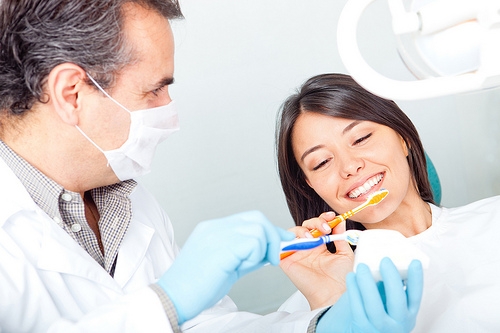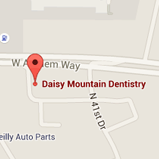Is there a correlation between my dental and cardiovascular health?
May 19th, 2021

YES! Studies have shown a correlation between gum disease and heart disease, underscoring the importance of good oral health care. Cardiovascular disease remains American’s leading killer, claiming more lives than the rest of major causes of death, according to our friends at the American Heart Association. In fact, an estimated 80 percent of American adults currently have some form of gum disease, also known as periodontal disease.
Studies suggest that people with gum disease are believed to have an elevated risk of heart attack and stroke. Since most patients are not regularly visiting a heart specialist, their regular visits to our Anthem office can help detect early warning signs of heart issues, prevent gum disease, or at the very least catch it at its early stage. We’d also like you to know your numbers: blood pressure (less than 120/80), cholesterol (less than 200) and BMI (less than 25).
There are many benefits to visiting Daisy Mountain Dentistry in addition to maintaining your dental health. If it has been a while since your last visit, please give us a call!
Is periodontal disease contagious?
May 12th, 2021

According to the Centers for Disease Control and Prevention, half of adults age 30 and over suffer from some form of gum disease. Caused by plaque buildup, gum disease is an infection of the tissue that surrounds and supports the teeth. In its advanced stages, it is known as periodontal disease. If left untreated, it can result in the loss of tissue and bone that support the teeth, causing teeth loss. It’s a preventable condition seen far too often by Drs. Peter Vogel, Vijal Vadecha.
Research between periodontal disease and other diseases is ongoing. Some studies have indicated that gum disease is linked to other health conditions such as stroke or diabetes. Furthermore, while most factors that lead to periodontal disease are dependent on the individual (genetics, diet, poor oral hygiene) there is a possibility that periodontitis is capable of spreading from one person to another.
What the Research Says
Periodontitis is a gum infection, and the bacteria that cause the gums to become infected travels in saliva. Researches have used DNA coding techniques to track the path of infection from one person to another. In other words, kissing and close contact play a role in the transmission of the infection, so if you’re married to a spouse with periodontal disease, then your chances of having gum problems are slightly increased. Other studies have indicated that saliva contact is common in family settings through coughing, sneezing, and shared utensils and food. Children with parents who have periodontal disease are at a somewhat higher risk of developing it. At the same time, just because you exchange bacteria with your loved ones doesn’t mean you will get periodontal disease.
It is important to note that the scientific evidence supporting the spread of periodontal disease is limited and ongoing. The best way to prevent gum disease is through proper plaque control, which includes brushing, flossing, mouthwash, and twice a year trips for professional cleanings. Contact our Anthem office if you have any questions about periodontal disease.
Is there a connection between oral health and school performance?
May 5th, 2021

As a parent, you want the best for your children, and that includes doing their best in school. You can support them by taking an interest in their activities, being enthusiastic about attendance, and helping them with homework. There may also be one more way you can help your children succeed at school. Surprisingly, research suggests that children with better oral health are likely to do better in school.
What the Research Says
One study in North Carolina looked at risk factors for poor school performance among school-aged children. As expected, the study found poor school performance linked to low socioeconomic status, low levels of parental education, and poor overall health. However, it also found a strong link between poor oral health and poor school performance, with children classified as having poor oral health 40 percent more likely struggle in school.
These findings are generalizable to the rest of the country. For example, attendance is an important factor in academic achievement, but dental conditions are responsible for a loss 51 million school hours among schoolchildren each year. Dental pain and infection are linked to poorer performance.
School-Based Programs to Promote Oral Health
In light of the apparent benefits of good oral health for school performance, some schools are taking steps to promote better oral care and health. In Maine, for instance, schools in need can apply for grants through School Oral Health Program (SOHP). The SOHP consists of four components:
- Oral health education for all children to support healthy behaviors
- A weekly fluoride mouth rinse to strengthen teeth
- Dental screenings to identify children who may need dental care
- Dental sealants, or plastic coatings, on back teeth to guard against decay
The State of Maine also supports an “Annual Sugar Out Day” to raise awareness of the effects of sugar on dental health and to help students choose low-sugar alternatives.
Oral Health Habits to Adopt
You can help your child improve oral health and do better in school by encouraging good oral hygiene. This includes brushing at least twice a day with a fluoride-containing toothpaste, and reminding your child to drink water after eating. Also, regular trips to our Anthem office can help prevent serious tooth problems.
Top Five Best Foods for Oral Health
April 28th, 2021

Some foods are just terrible for your teeth — think cookies and candy bars — but there are certain foods that are beneficial to your oral health. Below, Drs. Peter Vogel, Vijal Vadecha and our team have covered five of the top foods to keep your teeth and gums healthy!
1. Crispy, low-acid fruits and vegetables: Fruits like apples and vegetables such as carrots and celery act like “natural toothbrushes,” helping to clear plaque from your teeth and freshen your breath.
2. Kiwis: These little green superstars are packed with vitamin C which is essential for gum health. The collagen in your gums is strengthened when you consume foods that are high in vitamin C, like kiwis, thus helping to prevent periodontal problems.
3. Raw onions: Onions have long been studied for their antimicrobial, antibacterial, and antioxidant properties. Proliferation of bacteria is what leads to tooth decay and cavities. By including raw onions in your diet, you'll be doing your part to wipe out those little microbes before they can multiply!
4. Shiitake Mushrooms: A specific compound in shiitake mushrooms, lentinan, has been shown to have antibacterial properties that target the microbes that cause cavities while leaving other beneficial bacteria alone. It may also help prevent gingivitis, or inflammation of the gums.
5. Green Tea: Often lauded for its high antioxidant content and many health benefits, it turns out green tea also benefits your oral health! A Japanese study found men who drank green tea on a regular basis had a lower occurrence of periodontal disease compared to men who drank green tea infrequently. It's believed this is due to the catechins in green tea, a type of flavonoid that may help protect you from free radical damage, but more research needs to be done. Either way, drink up for your overall health, as well as your teeth!
If you have any questions about your oral health, or are looking for even more oral health tips, contact our Anthem office!


